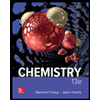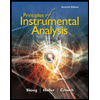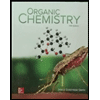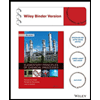
Concept explainers
Interpretation:
The masses of all possible
Concept introduction:
Mass spectrometry is a technique used to analyze the structure and chemical properties of different molecules. In this technique, molecules are bombarded with electrons in order to convert them into highly energetic positively charged ions, called molecular ions. The molecular ions may undergo further breakup into smaller ions, called fragment ions.
The molecular ions and the fragment ions are separated by deflection in a variable magnetic field according to their mass to charge ratio
The formula to calculate the molecular mass of a compound is,
Answer to Problem 2.137P
The all possible molecular and fragment ions formed during the mass spectrometry of the compound
The masses of the ions in
Explanation of Solution
The two naturally occuring
Therefore the molecular and fragment ions for the compound
The formula to calculate the molecular mass of
Substitute
The formula to calculate the molecular mass of
Substitute
The formula to calculate the molecular mass of
Substitute
The formula to calculate the molecular mass of
Substitute
The formula to calculate the molecular mass of
Substitute
The formula to calculate the molecular mass of
Substitute
The masses of ions
The all possible molecular and fragment ions formed during the mass spectrometry of the compound
The masses of the ions in
Want to see more full solutions like this?
Chapter 2 Solutions
MCGRAW: CHEMISTRY THE MOLECULAR NATURE
- Identify all functional groupsarrow_forwardA mixture of CaCO3 and MgC2O4 of unknown mass was heated in a 0.5 L closed rigid vessel to 900 degrees C.at 400C the following reaction occurs:MgC2O4 -> MgO (s) + CO (g) + CO2 (g)At 700C a second reaction occurs: CaCO3 -> CaO (s) + CO2 (g)The solid mass in the vessel was measured to be 3.06 g at 400C and 2.03g at 900CQuestion: What is the partial pressure of CO in both temperatures? (400 and 900C), provide detailed explanation.arrow_forwardFor the following alkyne, complete the reaction sequentially (that is draw the intermediate that we can’t stop at) and then name (complete name) all 3 molecules.arrow_forward
- Given the reaction sequence below, answer the following. A. Provide the structure for A. B. Provide the structure for B (pay attention to stereochemistry). C. Provide the structure for C. D. What are the stereochemical designations for I and II (R/S)?arrow_forwardWhich of the following is the most stable carbon radical?arrow_forwardPut the following carbon radicals in order of increasing stability.arrow_forward
- Draw the major organic product for each of the following reactions (pay attention to stereochemistry).arrow_forwardThere are 2 reactions (that you know of) to achieve the following transformation: One reaction is favored over the other because it avoids a competing reaction. A. Draw the favored reaction scheme (not the mechanism), be sure to include all necessary reagents. B. Draw the reaction scheme that is not favored and include all the possible products.arrow_forwardBoth carbocations and carbon-radicals have trigonal planar geometry. True or Falsearrow_forward
- Teflon (polytetrafluoroethene) is prepared via the radial polymerization of tetrafluoroethene. What other reaction conditions (reagent, etc.) are needed to accomplish this? A. NBS, Light B. Heat, Cl2 C. Peroxide, Heat D. H2SO4, H2O, Heatarrow_forwardWhich of the following compounds can be reacted with ethene to prepare 1,1- dichlorocyclopropane? A. CCl4 B. CCl2 C. CHCl3 D. CH2Cl2arrow_forwardusing any reactions, starting with propene, propose a synthesis for the following moleculearrow_forward
 ChemistryChemistryISBN:9781305957404Author:Steven S. Zumdahl, Susan A. Zumdahl, Donald J. DeCostePublisher:Cengage Learning
ChemistryChemistryISBN:9781305957404Author:Steven S. Zumdahl, Susan A. Zumdahl, Donald J. DeCostePublisher:Cengage Learning ChemistryChemistryISBN:9781259911156Author:Raymond Chang Dr., Jason Overby ProfessorPublisher:McGraw-Hill Education
ChemistryChemistryISBN:9781259911156Author:Raymond Chang Dr., Jason Overby ProfessorPublisher:McGraw-Hill Education Principles of Instrumental AnalysisChemistryISBN:9781305577213Author:Douglas A. Skoog, F. James Holler, Stanley R. CrouchPublisher:Cengage Learning
Principles of Instrumental AnalysisChemistryISBN:9781305577213Author:Douglas A. Skoog, F. James Holler, Stanley R. CrouchPublisher:Cengage Learning Organic ChemistryChemistryISBN:9780078021558Author:Janice Gorzynski Smith Dr.Publisher:McGraw-Hill Education
Organic ChemistryChemistryISBN:9780078021558Author:Janice Gorzynski Smith Dr.Publisher:McGraw-Hill Education Chemistry: Principles and ReactionsChemistryISBN:9781305079373Author:William L. Masterton, Cecile N. HurleyPublisher:Cengage Learning
Chemistry: Principles and ReactionsChemistryISBN:9781305079373Author:William L. Masterton, Cecile N. HurleyPublisher:Cengage Learning Elementary Principles of Chemical Processes, Bind...ChemistryISBN:9781118431221Author:Richard M. Felder, Ronald W. Rousseau, Lisa G. BullardPublisher:WILEY
Elementary Principles of Chemical Processes, Bind...ChemistryISBN:9781118431221Author:Richard M. Felder, Ronald W. Rousseau, Lisa G. BullardPublisher:WILEY





